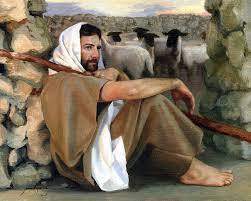By Monika Manser
Introduction
The most frequent way of praying that Saint Ignatius uses is that of imagining ourselves in a Gospel scene. We imagine ourselves as a character in the story. We take part in the story, seeing Jesus and all the other people, being aware of what’s going on and how we are feeling. The purpose of praying with the imagination is to allow Christ in the Scripture to speak to us. To bring the Gospel stories to life for us. We are not trying to recreate history. It doesn’t matter if your imagination takes the story off in a different direction to the Scripture. It doesn’t matter if the story takes place in 1st century Palestine or where we live now in the 21st century. What is important is what God wants to say to us through this passage.
Let us sit and relax so that together we can contemplate the Gospel using our imagination.
Prayer
We acknowledge we are in the presence of God so let us say together:
Direct O Lord and guide and influence all that is happening in my mind and heart during this time of prayer: all my moods and feelings, my memories and imaginings; my hopes and desires; may all be directed and influenced to your greater glory, praise and service and to my growth in your Spirit.
Amen
Let the Spirit guide our hearts and enlighten our minds as we read the Gospel and reflect on what it means to envisage Jesus as a shepherd. Let the Spirit enter you so that you too can hear the voice of Jesus, our shepherd.
Reading
John 10:1-10
Jesus said to the Jews: “I tell you most solemnly, anyone who does not enter the sheepfold through the gate. but gets in some other way is a thief and a brigand. The one who enters through the gate is the shepherd of the flock; the gate-keeper lets him in, the sheep hear his voice, one by one he calls his own sheep and leads them out. When he has brought out his flock, he goes ahead of them, and the sheep follow because they know his voice. They never follow a stranger but run away from him: they do not recognise the voice of strangers.”
Jesus told them this parable but they failed to understand what he meant by telling it to them.
So Jesus spoke to them again:
“I tell you most solemnly,
I am the gate of the sheepfold.
All others who have come
are thieves and brigands;
but the sheep took no notice of them.
I am the gate.
Anyone who enters through me will be safe:
he will go freely in and out
and be sure of finding pasture.
The thief comes
only to steal and kill and destroy.
I have come
so that they may have life
and have it to the full.”
Contemplation
Today , the Fourth Sunday of Easter is also know as Good Shepherd Sunday because in each of the 3 Lectionary Cycles, we reflect on Jesus as the Good Shepherd as described in Chapter ten of John’s Gospel. Jesus says, “I AM the gate of the sheepfold.” and is the second of the seven ‘I AM’ statements made by Jesus in this Gospel. Imagine the scene, find a place within it. With the help of the Spirit, let the image of Jesus as the gate of the sheepfold unfold in your imagination.
- Who are you within the story? Are you one of his disciples? Or one of the Jews listening to Jesus? Or a Shepherd? Or even one of the sheep? Perhaps a person that is not specially mentioned in the printed story?
- Where are you listening to Jesus? Outside? In the temple? In someone’s house?
- What time of day is it? Morning? Noon? Evening?
- What is the weather like? Hot? Cool? Windy?
- Are there many people listening? If so where are you in this crowd? In the middle? On the margins? Look around you and notice those who are listening. What kind of people does the crowd comprise? What is their mood like? What do you notice about your own feelings as you listen?
- As you listen to Jesus’ voice, what do you detect? Is his voice gentle, firm, comforting, strong?
- Given that shepherds in Jesus’ time were on the margins of society and whose social status was equivalent to that of tax-collectors, how do you react to Jesus’ parable relating to sheep, shepherds and brigands?
- How do you react to Jesus comparing himself to the gate of the sheepfold? What images are conjured up in your mind as you hear this? Is it one of security, safety and comfort?
- Do you like the analogy Jesus is making regarding the relationship between the shepherd and his sheep? Do you find it comforting knowing that the relationship between a shepherd and his sheep is one of familiarity and trust? Do you hear a voice of love because Jesus tells you he will keep you from harm and lead you to the safety of the sheepfold? Do you find freedom in this analogy in that you can come and go from the pen, but Jesus is always there tor your safety?
- Are you outraged because you feel Jesus is comparing you to a sheep (which can be stupid and trusting), a brigand or a thief (who are both cunning and not to be trusted)? Do you find the analogy of the sheepfold restricting or Jesus being the gate inhibiting? Why?
- Do you feel Jesus’ words are giving you direction in your life i.e. telling you that “anyone who enters through me will be safe” or are you confused and flustered?
- How do you recognise the voice of Jesus amidst all the other voices competing for your attention?
- Feel what is going on inside you as you listen to Jesus’ words. Is there anything you want to ask him? Do you want him to explain to you what He means about Him being the gateway to eternal life?
- Approach Jesus and talk to him about what is going on inside you. Listen to what he tells you.
Sit and imagine the scene and perhaps write down how and what you feel, your emotions – anything that comes into your mind.
Sharing
Let us now share what we thought, felt etc. only if you are comfortable to do so.
End Prayer
Suscipe of St. Ignatius of Loyola
Take, Lord, and receive all my liberty,
my memory, my understanding,
and my entire will,
All I have and call my own.
You have given all to me.
To you, Lord, I return it.
Everything is yours; do with it what you will.
Give me only your love and your grace,
that is enough for me.
Scripture texts: from the Jerusalem Bible 1966 by Dartington Longman & Todd Ltd and Doubleday and Company Ltd




